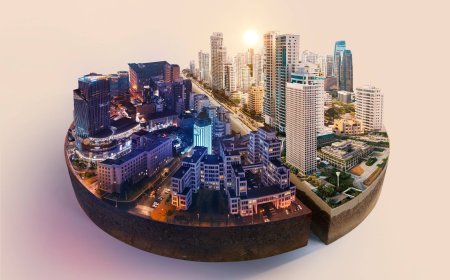How to Discover the Corrales Suburbs Albuquerque
How to Discover the Corrales Suburbs Albuquerque Located just north of Albuquerque, New Mexico, the village of Corrales is a unique blend of rural charm, artistic heritage, and suburban comfort. Often described as a hidden gem within the greater Albuquerque metropolitan area, Corrales offers residents and visitors a slower pace of life without sacrificing access to urban amenities. Yet, despite it
How to Discover the Corrales Suburbs Albuquerque
Located just north of Albuquerque, New Mexico, the village of Corrales is a unique blend of rural charm, artistic heritage, and suburban comfort. Often described as a hidden gem within the greater Albuquerque metropolitan area, Corrales offers residents and visitors a slower pace of life without sacrificing access to urban amenities. Yet, despite its growing popularity, many people remain unaware of its distinct character, history, and the subtle ways it differs from surrounding suburbs. Discovering the Corrales suburbs isn’t about simply locating it on a map—it’s about understanding its culture, geography, community dynamics, and the intentional design that makes it stand out in the Southwest. This guide provides a comprehensive, step-by-step roadmap to uncovering what makes Corrales not just a suburb, but a destination worth exploring in depth.
Whether you’re considering relocating, planning a visit, researching real estate, or simply curious about the region’s lesser-known neighborhoods, this tutorial will equip you with the knowledge and tools to navigate Corrales with confidence. Unlike generic travel guides or superficial listings, this resource dives into the authentic layers of Corrales—from its acequia-fed farmlands to its historic adobe architecture—and shows you how to experience it beyond the surface. By the end, you’ll know how to identify authentic Corrales neighborhoods, connect with local communities, access hidden trails, and understand the zoning and development patterns that define its character.
Step-by-Step Guide
Step 1: Understand the Geographic Context of Corrales
Corrales is not a neighborhood within Albuquerque—it is an incorporated village with its own government, zoning laws, and identity. Located approximately 12 miles north of downtown Albuquerque along the Rio Grande, it sits between the city limits of Albuquerque and the town of Rio Rancho. To truly discover Corrales, begin by mapping its boundaries. The village is bounded by the Rio Grande to the east, the Sandia Mountains to the east and northeast, and the expansive high desert to the west. Unlike typical suburban sprawl, Corrales maintains strict land-use regulations that preserve its rural aesthetic, including large lot sizes (often 1–5 acres), restrictions on commercial development, and mandatory setbacks from roads.
Use topographic and satellite imagery tools like Google Earth or USGS Topo Maps to visualize how Corrales is nestled in a floodplain corridor along the river. Notice the contrast between the dense, grid-based neighborhoods of Albuquerque and the scattered, organic layout of Corrales homes, many of which are surrounded by orchards, fields, and cottonwood groves. This spatial distinction is critical—it’s the first visual clue that you’re entering a different kind of community.
Step 2: Explore the Historic Core and Main Street
The heart of Corrales is its historic village center, anchored by Corrales Road (NM-47) and the intersection with Rio Grande Boulevard. This area, often called “Downtown Corrales,” is not a commercial mall or shopping center—it’s a modest cluster of locally owned businesses, a post office, a library, and a few cafes. Walk or bike along Corrales Road between 9 AM and 4 PM on a weekday to observe the rhythm of daily life. Notice the absence of chain stores; instead, you’ll find the Corrales Bakery, the Corrales Bookstore, and the historic Corrales General Store, which has operated since the 1940s.
Visit the Corrales Community Center and the adjacent library, which hosts local history exhibits and rotating art shows. These spaces are not tourist attractions—they are community hubs. Engaging with staff or attending a free event (like a farmers market or book club) gives you insight into the values of residents: sustainability, localism, and preservation. Don’t rush. Spend at least an hour here. The quietude and lack of signage are intentional. This is not a place designed for foot traffic—it’s designed for belonging.
Step 3: Identify the Subdivisions and Neighborhood Types
Corrales is not monolithic. It consists of several distinct residential zones, each with its own architectural style and history. The primary neighborhoods include:
- Old Corrales: The oldest section, featuring historic adobe homes built between the 1880s and 1950s. These properties often have thick walls, wooden vigas, and large patios. Many are on 2–5 acre lots with fruit trees and irrigation ditches (acequias).
- Corrales Ranch: A mid-century subdivision developed in the 1960s–70s. Homes here are more modern but still adhere to low-density standards. Expect brick or stucco homes on 1–2 acre lots, often with private wells and septic systems.
- Corrales Heights: Located on the western edge, this area features slightly larger lots and newer construction (1990s–2000s). Homes here are more likely to have solar panels, xeriscaped yards, and detached garages.
- River Corridor: Properties directly adjacent to the Rio Grande, often with private access to trails and fishing spots. These are the most coveted—and expensive—lots, with strict conservation easements.
To identify these areas, use the Bernalillo County Property Appraiser’s GIS map. Search by parcel number or street name and look at lot size, year built, and zoning classification. Properties zoned “R-1” are typically single-family residential with large setbacks. Avoid areas zoned “C-1” or “C-2”—those are commercial corridors and not part of the residential Corrales experience.
Step 4: Follow the Acequias and River Trails
One of the most defining features of Corrales is its network of acequias—centuries-old, community-managed irrigation ditches that date back to Spanish colonial times. These are not just water channels; they are cultural landmarks and public greenways. Walking alongside an acequia is like stepping into a living museum. The most accessible are the Corrales Acequia and the San Ysidro Acequia, which run parallel to Corrales Road and connect to the Rio Grande Trail.
Download the Rio Grande Trail map from the City of Albuquerque’s Parks and Recreation site. The trail stretches 16 miles from the northern edge of Corrales to the southern edge of Albuquerque. In Corrales, the trail passes through cottonwood forests, crosses wooden bridges, and offers views of the Sandias. Use the trail to access neighborhoods not visible from main roads. Many homes have private paths leading to the trail—look for small wooden signs that say “Public Trail Access.” These are legal and maintained by the Corrales Acequia Association.
Bring a field notebook. Record the types of vegetation, the condition of the ditch banks, and the presence of wildlife. You’ll notice that properties with well-maintained acequias are often older, cared-for homes. Neglected acequias may indicate absentee ownership or financial strain—a subtle but telling sign of neighborhood health.
Step 5: Engage with Local Institutions and Events
Real discovery happens through interaction. Corrales has a robust calendar of community events that reveal its soul:
- Corrales Farmers Market: Held every Saturday morning from May to October at the Community Center. Over 50 vendors sell organic produce, handmade cheeses, pottery, and honey. This is where locals shop—not at Walmart or Trader Joe’s.
- Corrales Art Walk: Twice a year, in spring and fall, local artists open their studios to the public. You’ll find painters working in adobe studios, sculptors using river stone, and weavers using wool from local sheep.
- Acequia Day: Celebrated in late April, this event includes ditch cleaning, educational talks, and traditional New Mexican food. Participation is open to all—no invitation needed.
Attend one event. Talk to vendors, artists, or volunteers. Ask: “How long have you lived here?” “What brought you to Corrales?” “What’s changing?” These questions will yield more insight than any real estate listing. Many residents moved here for the land, the quiet, or the sense of history—not for school districts or commute times.
Step 6: Study the Zoning and Development Patterns
Corrales has resisted urbanization through deliberate policy. The village code prohibits multi-family housing, fast-food chains, and billboards. To understand its character, study the zoning ordinance available on the official Corrales Village website. Key provisions include:
- Minimum lot size: 1 acre for most residential zones
- Maximum building height: 30 feet
- Setbacks: 30 feet from roads, 50 feet from property lines
- No commercial signage without a special permit
Compare this to neighboring areas like Albuquerque’s North Valley or Rio Rancho, where 1/4-acre lots and strip malls dominate. The contrast is stark. Corrales’ zoning isn’t just about aesthetics—it’s a form of environmental and cultural preservation. This is why property values remain stable even during market downturns: scarcity and regulation create enduring value.
Use the Corrales Village Planning Department’s interactive zoning map to overlay property lines, easements, and conservation areas. Look for properties flagged as “Open Space” or “Agricultural.” These are often the most desirable because they cannot be subdivided or developed further.
Step 7: Access Public Records and Historical Archives
To uncover the deeper story of Corrales, visit the Albuquerque Public Library’s Center for Southwest Research. They house digitized land deeds, photographs from the 1920s, and oral histories from longtime residents. Search for “Corrales Acequia Records” or “Corrales Land Grants.” You’ll find that many original land grants were issued in the 1700s under Spanish law, and the community still honors those boundaries today.
Also explore the New Mexico Historic Preservation Division’s database. Corrales has over 30 properties listed on the National Register of Historic Places, including the Corrales Church (built 1885) and the old schoolhouse. These aren’t museums—they’re still in use. The church holds weekly services; the schoolhouse is now a community center. Seeing them in context, not as relics, completes your understanding.
Step 8: Observe Transportation and Infrastructure
Corrales has no public transit. Residents rely on personal vehicles, bicycles, and walking. The village has no traffic lights. This is intentional. The lack of infrastructure signals a deliberate choice to limit growth and maintain tranquility.
Drive slowly along Corrales Road and note the speed limit signs (25 mph), the wide shoulders, and the absence of streetlights after dusk. Look for bike racks outside the bakery and the library. Notice how many homes have large driveways but no garages—many residents use them for gardening tools or storage, not cars.
Compare this to nearby suburbs where wide roads, traffic signals, and strip lighting dominate. Corrales’ infrastructure tells you everything: this is a place designed for people, not cars.
Step 9: Identify the Cultural Signifiers
Corrales is deeply rooted in New Mexican culture. Look for these subtle signs:
- Red or green chile peppers drying on fences
- Adobe walls with hand-plastered finishes
- Low, flat-roofed homes with wooden lintels
- Outdoor altars or “bultos” (religious carvings) near doorways
- Hand-painted signs in Spanish and English
These aren’t decorative—they’re functional and cultural. The chile drying on fences is a food preservation method. The adobe walls regulate temperature. The bultos honor ancestors. These are not tourist props—they’re lived traditions.
Visit a local home during the holidays. Many residents celebrate Las Posadas (a Christmas procession) or Día de los Muertos with altars in their yards. You won’t find these events advertised on social media. They’re passed down through generations.
Step 10: Measure Your Own Fit
Discovering Corrales isn’t just about observation—it’s about self-assessment. Ask yourself:
- Do I value quiet over convenience?
- Can I adapt to a slower pace of life?
- Am I comfortable with limited retail options?
- Do I appreciate historic architecture and manual labor in home maintenance?
- Can I participate in community efforts, like ditch maintenance or art events?
Corrales isn’t for everyone. It demands engagement. But for those who resonate with its rhythm, it offers something rare: a sense of place that’s been preserved, not packaged.
Best Practices
Practice 1: Prioritize On-the-Ground Exploration Over Online Listings
Real estate portals like Zillow or Redfin often mislabel Corrales properties as “Albuquerque suburbs.” This is inaccurate. Corrales is a separate municipality. Always verify the mailing address and ZIP code (87048). Properties listed as “North Albuquerque” or “Near Corrales” are not in Corrales. Visit in person. Drive the roads. Talk to neighbors. Listings can’t capture the scent of wet earth after a monsoon, the sound of water in an acequia, or the silence of a moonlit desert night.
Practice 2: Respect Private Property and Cultural Boundaries
Many Corrales homes are on large lots with no fences. That doesn’t mean they’re public. Always stay on public trails or sidewalks. Never enter a yard without permission. The community values privacy. If you see someone working in their garden, offer a polite greeting—but don’t intrude. This is not a theme park. It’s a home.
Practice 3: Learn Basic Spanish Phrases and Cultural Norms
While English is widely spoken, Spanish remains part of daily life. Knowing phrases like “Buenos días,” “Gracias,” or “¿Dónde está el camino?” (Where is the path?) builds rapport. Avoid assumptions. Not everyone is of Hispanic descent, but many respect the cultural heritage. Don’t refer to “Mexican food”—it’s New Mexican cuisine, distinct in flavor and history.
Practice 4: Support Local Businesses and Avoid Chains
Corrales thrives because residents choose local. Eat at the Corrales Coffee House, buy produce at the farmers market, and use local contractors for repairs. Avoid chain restaurants or big-box stores. Your spending supports the village’s economic model and reinforces its identity.
Practice 5: Participate, Don’t Just Observe
Don’t be a tourist. Attend a village council meeting. Volunteer to help clean an acequia. Join the Corrales Historical Society. These aren’t obligations—they’re invitations to belong. The most meaningful discoveries come from participation, not observation.
Practice 6: Document Your Experience Thoughtfully
Keep a journal or photo log. Note the season, time of day, weather, and your emotional response. Over time, you’ll see patterns: how the light hits the Sandias at sunset, how the acequias dry in late summer, how the community comes together after a storm. These are the details that define place.
Practice 7: Understand Environmental Constraints
Corrales is in a high desert region with limited water. Homes rely on wells and acequias. Droughts are common. If you’re considering relocation, research water rights and conservation requirements. Xeriscaping is mandatory on new builds. This isn’t a trend—it’s survival. Respect it.
Practice 8: Avoid Gentrification Mindsets
Corrales has resisted rapid development because residents fiercely protect its character. Avoid language like “fixing up” or “modernizing” historic homes. These terms imply the past is flawed. Instead, use “preserving,” “restoring,” or “honoring.” Your attitude shapes your experience—and the community’s response to you.
Practice 9: Build Relationships, Not Just Contacts
Don’t collect business cards. Ask questions. Listen. Offer help. Bring homemade bread to a neighbor. Share seeds from your garden. Corrales doesn’t operate on transactional relationships. It thrives on reciprocity.
Practice 10: Return Repeatedly
Corrales reveals itself slowly. Visit in spring, summer, fall, and winter. Each season transforms the landscape. In winter, the acequias freeze; in summer, they overflow. The orchards bloom in April, the chile ripens in August, and the cottonwoods turn gold in October. To know Corrales is to witness its cycles.
Tools and Resources
Official Resources
- Corrales Village Website: www.corrales.org – Access zoning codes, meeting minutes, event calendars, and contact information for planning departments.
- Bernalillo County GIS Map: www.bernco.gov/gis – Interactive property maps with ownership, lot size, and zoning data.
- Corrales Acequia Association: www.corralesacequia.org – Learn about water rights, ditch maintenance, and community stewardship.
- Rio Grande Trail Map: www.cabq.gov/parks/rio-grande-trail – Official trail access points, restrooms, and safety guidelines.
Historical and Cultural Archives
- Center for Southwest Research, UNM Libraries: Digitized land grants, photographs, and oral histories from Corrales residents.
- New Mexico Historic Preservation Division: National Register listings and preservation guidelines for historic structures.
- Corrales Historical Society: Publishes newsletters, hosts lectures, and maintains a small archive of village records.
Books and Media
- “The Acequia: Water for Life in New Mexico” by William deBuys – A profound exploration of acequia culture.
- “Corrales: A Village in the Valley” by Mary Ellen Lepionka – A photographic and historical record of the community.
- “New Mexico: A History” by William H. Leckie – Provides context for Spanish land grants and colonial settlement patterns.
- Documentary: “Water and the West” (PBS) – Features segments on acequia systems in Corrales and surrounding areas.
Apps and Digital Tools
- Google Earth Pro: Use the historical imagery slider to see how Corrales has changed since the 1980s.
- AllTrails: Search “Rio Grande Trail Corrales” for user reviews and trail conditions.
- Nextdoor (Corrales Neighborhood): A hyperlocal forum where residents post about events, road closures, and lost pets. Not for real estate—just community.
- OpenStreetMap: More accurate than Google Maps for rural roads and acequia paths.
Local Experts to Connect With
- Corrales Public Library Staff – Often know local history and can direct you to archives.
- Members of the Corrales Art Guild – Open studios during Art Walks; passionate about community.
- Volunteers at the Corrales Farmers Market – Most are lifelong residents with deep knowledge.
- County Extension Agents – Can explain water rights, soil conditions, and native plantings.
Real Examples
Example 1: The Martinez Family – Three Generations in One Adobe
The Martinez family has lived in the same adobe home on Corrales Road since 1923. The house was built by their great-grandfather using hand-molded adobe bricks. The family maintains the original acequia that runs alongside the property, repairing it every spring with community help. They grow chile, corn, and apples. Their children now live in Albuquerque but return every weekend to tend the garden. “This isn’t a house,” says Maria Martinez, 72. “It’s a promise we made to our ancestors.”
Example 2: The Riverfront Property – Conservation Over Development
In 2018, a developer offered $1.2 million for a 3-acre riverfront lot in Corrales. The owner, a retired teacher, refused. Instead, she placed a conservation easement on the land through the Land Trust for Santa Fe. The property is now protected forever. No homes, no roads, no fences. Just cottonwoods, sandhill cranes, and the river. “I didn’t want it to become another subdivision,” she said. “I wanted it to remain wild.”
Example 3: The Acequia Restoration Project
In 2021, a group of residents organized a month-long effort to clear debris from the San Ysidro Acequia. Over 120 volunteers showed up—teachers, engineers, teens, retirees. They removed invasive tamarisk, repaired earthen banks, and replanted native grasses. The project was funded by a $15,000 grant from the state, but the labor was all volunteer. Today, the acequia flows stronger than it has in 50 years. It’s now a model for other communities.
Example 4: The Corrales Bookstore – A Cultural Anchor
Opened in 1987, the Corrales Bookstore has never had a website. It survives on word-of-mouth and community support. The owner, a former librarian, hosts weekly poetry readings. She keeps a ledger of who buys what—and sometimes, she lets people take books if they can’t pay. “Books are meant to be shared,” she says. The store doesn’t make a profit. But it’s the heart of the village.
Example 5: The First-Time Visitor Who Stayed
After a weekend road trip in 2019, a couple from Denver stopped in Corrales on a whim. They walked the trail, ate breakfast at the bakery, and met a woman selling homemade preserves. They returned three months later to buy a home. “We thought we wanted the city,” they wrote in a letter to the village. “But we found peace here. We didn’t know we were looking for it.”
FAQs
Is Corrales part of Albuquerque?
No. Corrales is an independent incorporated village with its own government, police force, and zoning laws. It is located within Bernalillo County and is part of the Albuquerque metropolitan statistical area, but it is not a neighborhood or suburb of Albuquerque in the administrative sense.
Can I visit Corrales as a tourist?
Yes. Corrales welcomes visitors who respect its character. Walk the Rio Grande Trail, visit the farmers market, and dine at local cafes. Avoid intrusive photography, loud behavior, or trespassing on private property.
Are there schools in Corrales?
Corrales has one public elementary school (Corrales Elementary) and no public high school. Middle and high school students attend schools in Albuquerque or Rio Rancho via school bus. Many families choose homeschooling or private education.
What is the cost of living in Corrales?
Housing costs are higher than the Albuquerque average due to limited supply and strict zoning. Median home prices range from $600,000 to $1.2 million. Property taxes are moderate, but maintenance costs can be higher due to older infrastructure and large lots.
Is there public transportation to Corrales?
No. Corrales has no public transit. Residents rely on personal vehicles. The nearest bus stop is in Albuquerque, about 15 minutes away.
Can I build a new home in Corrales?
Yes, but with strict limitations. Minimum lot size is 1 acre. Buildings must be under 30 feet tall. Commercial use is prohibited. New construction must follow traditional Southwestern architectural styles. Permits are reviewed by the village planning board.
Why are there so many fruit trees in Corrales?
Historically, Corrales was an agricultural community. The acequias provided reliable irrigation, making it ideal for orchards. Many residents still maintain apple, peach, and apricot trees as a cultural tradition and food source.
Is Corrales safe?
Yes. Corrales has one of the lowest crime rates in the region. The village has a small police force and a strong sense of community vigilance. Most doors are left unlocked.
How do I learn about upcoming events?
Check the Corrales Village website, visit the community center bulletin board, or stop by the library. Events are rarely advertised online—most are shared through word of mouth.
What makes Corrales different from other New Mexico suburbs?
Corrales prioritizes preservation over growth. It has no chain stores, no traffic lights, no high-density housing, and no billboards. Its identity is rooted in land stewardship, cultural heritage, and community participation—not convenience or commerce.
Conclusion
Discovering the Corrales suburbs of Albuquerque is not a checklist—it’s a journey. It requires patience, curiosity, and humility. You won’t find it by searching “best suburbs near Albuquerque” on Google. You’ll find it by walking an acequia at dawn, by listening to a neighbor tell the story of their grandfather’s adobe bricks, by tasting the first chile of the season, and by realizing that this place doesn’t want to be discovered—it wants to be understood.
Corrales is a rare example of a community that has chosen to remain small, quiet, and deeply connected to its land and history. In a world of rapid development and digital noise, it stands as a quiet rebellion. To discover it is to rediscover what it means to belong to a place—not just live in it.
Take your time. Return often. Listen more than you speak. And when you leave, don’t just take photos—take a seed. Plant it somewhere. Let Corrales grow in you, too.






























